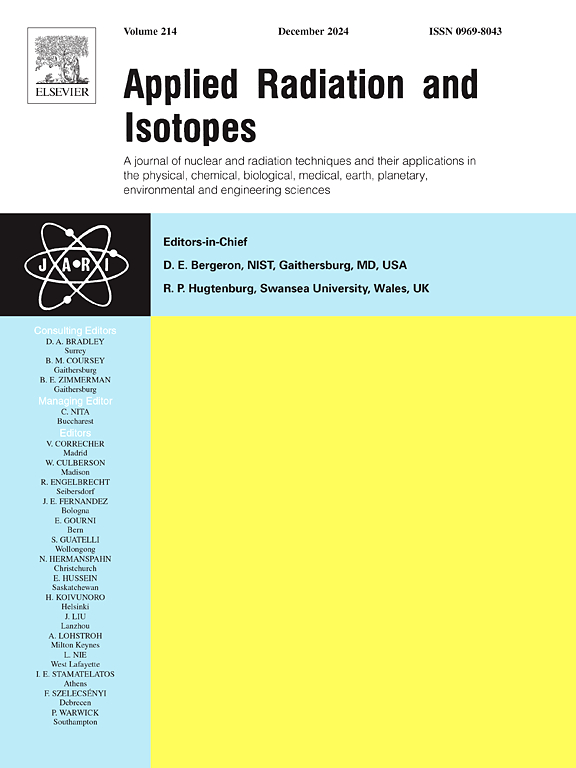3he粒子在27mev的天然银上诱导核反应的激活截面
IF 1.8
3区 工程技术
Q3 CHEMISTRY, INORGANIC & NUCLEAR
引用次数: 0
摘要
本研究提供了利用堆叠箔活化技术对天然银进行3he粒子辐照制备放射性核素104、104、105、106、110、107、104、104、104、104、104、104、108、108、109、110、110、110、111、111、107、109Cd的实验截面数据。通过与以前的研究进行比较,结果得到了验证,如果可能的话,对最新的γ射线发射进行了修正。利用监测反应验证了束流能量和电流,提高了数据的可靠性。实验激发函数进一步与帝国代码和TENDL-2023库的理论预测进行了比较,揭示了显著的差异,强调了³He弹丸核反应模型的改进需求。还计算了粗目标产量,¹⁰⁷In和¹⁰⁸In显示出最高的产量。产量一般不足以大规模生产放射性核素。这些结果扩展了现有的3he诱导核反应的实验数据库,为核反应建模的发展以及在活化分析和天体物理学中的应用提供了新的材料。本文章由计算机程序翻译,如有差异,请以英文原文为准。
Activation cross-sections of 3He-particle induced nuclear reactions on natural silver up to 27 MeV
This study presents new experimental cross-section data for the production of radionuclides 104ᵐ, 104g, 105ᵐ, 106ᵐ, 110ᵐAg, 107g, 108ᵐ, 108g, 109, 110ᵐ, 110g, 111In, and 107, 109Cd produced via 3He-particle irradiation of natural silver using the stacked-foil activation technique. The results were validated by comparison with previous studies, corrected for updated γ-ray emissions, if possible. Beam energy and current were verified using the monitor reactions, which improved data reliability. The experimental excitation functions were further compared with theoretical predictions from the EMPIRE code and the TENDL-2023 library, revealing notable discrepancies that underscore the need for refinement in nuclear reaction models for ³He projectiles. Thick target yields were also calculated, with ¹⁰⁷ᵍIn and ¹⁰⁸ᵐIn showing the highest production rates. The yields are generally insufficient for large-scale radionuclide production. These results anyhow extend the existing experimental database for 3He-induced nuclear reactions, contribute new material for the advancement of nuclear reaction modeling, as well as for applications in activation analysis and astrophysics.
求助全文
通过发布文献求助,成功后即可免费获取论文全文。
去求助
来源期刊

Applied Radiation and Isotopes
工程技术-核科学技术
CiteScore
3.00
自引率
12.50%
发文量
406
审稿时长
13.5 months
期刊介绍:
Applied Radiation and Isotopes provides a high quality medium for the publication of substantial, original and scientific and technological papers on the development and peaceful application of nuclear, radiation and radionuclide techniques in chemistry, physics, biochemistry, biology, medicine, security, engineering and in the earth, planetary and environmental sciences, all including dosimetry. Nuclear techniques are defined in the broadest sense and both experimental and theoretical papers are welcome. They include the development and use of α- and β-particles, X-rays and γ-rays, neutrons and other nuclear particles and radiations from all sources, including radionuclides, synchrotron sources, cyclotrons and reactors and from the natural environment.
The journal aims to publish papers with significance to an international audience, containing substantial novelty and scientific impact. The Editors reserve the rights to reject, with or without external review, papers that do not meet these criteria.
Papers dealing with radiation processing, i.e., where radiation is used to bring about a biological, chemical or physical change in a material, should be directed to our sister journal Radiation Physics and Chemistry.
 求助内容:
求助内容: 应助结果提醒方式:
应助结果提醒方式:


